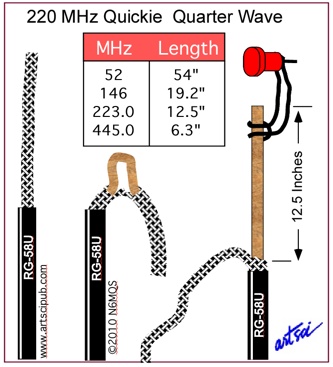 Guide to: Quickie Antennas |
Artsci Publishing |
| -- Table of Contents -- |
 Guide to: Quickie Antennas |
Artsci Publishing |
| -- Table of Contents -- |
 R
ebuilding a ham shack after moving into a new home is a very big job. Even if you only have a single VHF radio, running the coax and planting a new antenna system on the roof seems to take more effort each time you do it. Once you get used to drilling holes all the way through a wall for the coax, you are faced with how to support the antenna mast on the roof. If you are only renting the home, you may be tempted to strap the mast on the side of the house and limit the height to just over roof level.
R
ebuilding a ham shack after moving into a new home is a very big job. Even if you only have a single VHF radio, running the coax and planting a new antenna system on the roof seems to take more effort each time you do it. Once you get used to drilling holes all the way through a wall for the coax, you are faced with how to support the antenna mast on the roof. If you are only renting the home, you may be tempted to strap the mast on the side of the house and limit the height to just over roof level.After moving my family into a new home a few months ago, I set aside a weekend to work on my ham shack and antenna system. In my old house, I had an antenna for each band, 2 meters, 220 MHz and 440MHz. Since we are only renting this new home, I wanted to make use of a new multiband antenna. I drilled the holes, built the antenna and mast and bolted it to the side of the house. A triplexer (three port RF splitter) would breakout each band for connection to my three radios. I have used duplexers before, but this would be my first experience with a triplexer. I was ready to turn the radio on and test my new system. The radios were receiving properly, but my transmitter signal was not making connections to the local repeaters. I connected the antenna to each radio and everything was fine. I connected the triplexer and hooked up a SWR meter and discovered that the SWR through the triplexer was over 5 to 1. I couldn't understand how the receive signals made it through the triplexer but my transmitter could not. Luckily I had an old duplexer and hooked it up with great success. My 2 meter and 440 MHz radios could now operate properly. The 220 MHz radio was left without an antenna. It was now getting dark, I didn't want to drill another hole for another run of coax and there was no room on the mast for another antenna. I was not going to be defeated by that malfunctioning triplexer. I remembered that a 220 MHz quarter wave antenna could be made using a 12 1/2" wire for a radiator and a 13" wire for the ground plane. It was then that the inspiration for a quickie antenna hit me. I had a left over 6 foot piece of coax with a PL connector on one end. I removed 13" of outer insulation and exposed the shield. I measured down 12 1/2 inches and forced open the shield and folded the coax over and pulled out the center conductor with insulation through the hole in the shield. I now had a 220 MHz quarterwave antenna!! I hung it from the ceiling in my shack with a rubberband and a tack. I hooked it up to the meter and measured the SWR. It was perfect. This antenna can be built for any frequency you may need. Just make sure the length of the radiator is correct. If you need to look up the exact length for each band, see the Simpleton's Guide to Quarterwave Antennas. You may attach the radiator to a wood board to help support it. You must use RG-58 or similar size coax. The larger RG-8 style is much too hard to work with when you attempt to pull out the center insulation. You may be tempted to unbraid the shield instead of opening a hole and pulling out the center insulation. Try unbraiding the wire and you'll get so frustrated with the braid tangling in themselves, you'll cut off the work and start over. Good luck and remember to have fun when you work on the hobby we call Amateur Radio.
|
| Top of this page | Return to welcome page |
Artsci Publishing
Post Office Box 1428
Burbank, CA 91507
(818) 843-4080
Copyright ©1996 - 2026 artsci publishing all right reserved.